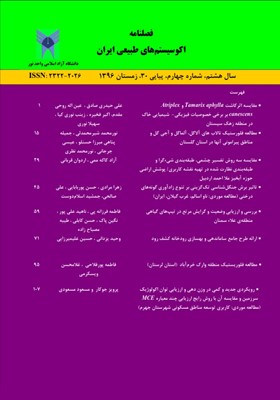مطالعه فلوریستیک منطقه وارک خرمآباد (استان لرستان)
محورهای موضوعی : مرتعداریفاطمه پورفلاحی 1 * , غلامحسن ویسکرمی 2
1 -
2 - دانشجوی دکتری ، بیوسیستماتیک گیاهی ، دانشگاه تهران
کلید واژه: شکل زیستی, فلور, خرمآباد, جغرافیای گیاهی, وارک,
چکیده مقاله :
چکیده منطقه وارک با مساحت 2000 هکتار در جنوبغربی خرمآباد واقع شده است. حداقل ارتفاع 1190 متر و حداکثر ارتفاع 1990 متر از سطح دریا می باشد. مطالعات انجام شده نشان داد که در منطقه مورد مطالعه 49 خانواده، 156 سرده و 254 گونه گیاهی وجود دارد. از مهم ترین خانواده های منطقه می توان خانوادهFabaceae(33 گونه) و Lamiaceae(27 گونه) را نام برد. تروفیت ها (47 درصد)، ژئوفیت ها (26 درصد)، کاموفیت ها (12 درصد)، همیکریپتوفیت ها (10 درصد) و فانروفیت ها (5 درصد) مهمترین گروههای ساختاری طیف زیستی منطقه به روش رانکایر بودند. از نظر عناصر رویشی منطقه، 43 درصد ایرانی – تورانی ، 23 درصد مدیترانهای و ایرانی– تورانی و 17 درصد چند منطقهای (ایرانی - تورانی، مدیترانهای و اروپا – سیبری) و 5 درصد عنصر جهانی می باشند. هدف از این تحقیق، شناسایی گونههای گیاهی منطقه وارک در شهرستان خرمآباد بوده است
Abstract The Vark region with an area of 2000 hectares is located at SW of Khorramabad, the lowest and the highest of its height are 1190 and 1990 meters. Flora of this region includes 254 plant species that belong to 156 genera and 49 families. the important families are Fabaceae and Lamiaceae , with 33 and 27 plant species respectively. Therophytes 47% , Geophytes 26% , Chamaephytes 12%, Hemichryptophytes 10% and Phanerophytes 5% and were the most important structure groups of the local biological spectrum according to Raunkaiaer method from the view point regional elements plants of this region include: 43% Irano – Touranean , 23% Mediterranean and Irano-Touranean،17% Mediterranean and Irano-Touranean and Europe – Siberean and 5% Cosmopolitan. The aim of this research was identify plant species in vark region of Khorramabad.
References
11. Djavanshir.K (1976). Atlas of woody plants of Iran. Publication of National Association for the Conservation of Natural Resources and Human Environment. in Persian.
12. Razavi, S A. and Esmailzadeh O., 2004. Introduction of flora, life form and plant geographical distribution of Oriental Beech (Fagus orientalis Lipsky) Stands in Vaz Forests. The fourth international Iran and Russia Conference, 8th- 10th September 2004, Shahrekord- Iran. Inpersian.
13. . Asri. Y (2008). Plant diversity in mouteh refuge, iran. Rostaniha, Vol. 9(1), pp: 25-37.
14. Ghahreman.A (1996). Basic phytology. vol 1,2. University of Tehran Press. In Persian.
15. Ghahreman.A;Attar.F (1998)Biodiversity of Iranian Plant Species. Vol1. University of Tehran Press. In Persian.
16. Karimi.H (1995). Weeds in Iran. University Publication Center. In Persian.
17. Veiskarami.G (2000). Fluorite Study of Lorestan Sefidkooh Area. A thesis submitted for degree of mater science ant natural resource. University of Tehran. In Persian.
_||_References
11. Djavanshir.K (1976). Atlas of woody plants of Iran. Publication of National Association for the Conservation of Natural Resources and Human Environment. in Persian.
12. Razavi, S A. and Esmailzadeh O., 2004. Introduction of flora, life form and plant geographical distribution of Oriental Beech (Fagus orientalis Lipsky) Stands in Vaz Forests. The fourth international Iran and Russia Conference, 8th- 10th September 2004, Shahrekord- Iran. Inpersian.
13. . Asri. Y (2008). Plant diversity in mouteh refuge, iran. Rostaniha, Vol. 9(1), pp: 25-37.
14. Ghahreman.A (1996). Basic phytology. vol 1,2. University of Tehran Press. In Persian.
15. Ghahreman.A;Attar.F (1998)Biodiversity of Iranian Plant Species. Vol1. University of Tehran Press. In Persian.
16. Karimi.H (1995). Weeds in Iran. University Publication Center. In Persian.
17. Veiskarami.G (2000). Fluorite Study of Lorestan Sefidkooh Area. A thesis submitted for degree of mater science ant natural resource. University of Tehran. In Persian.

